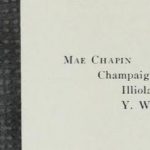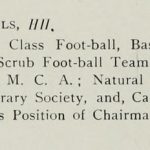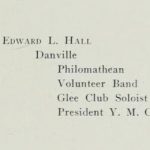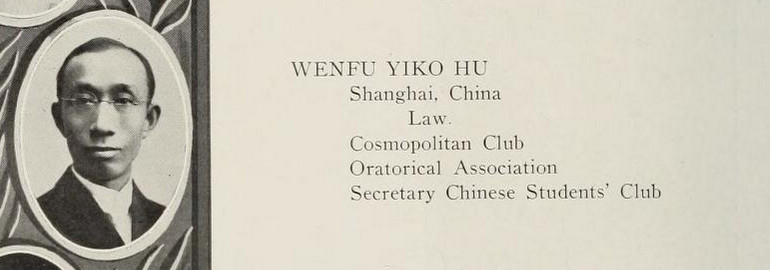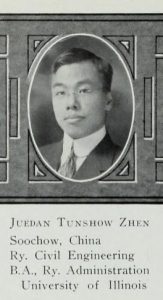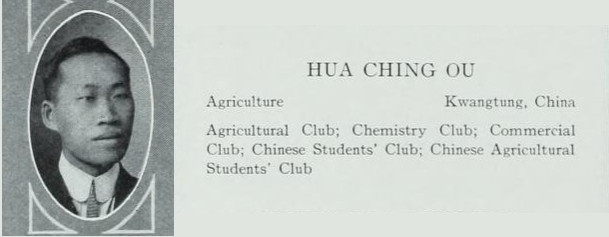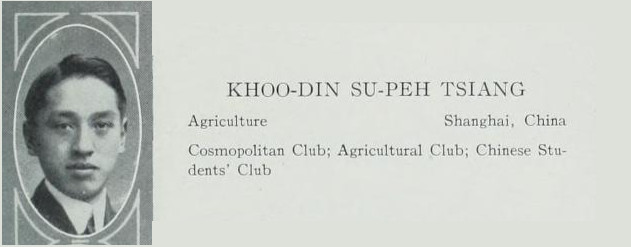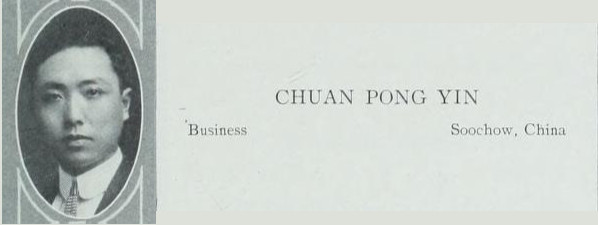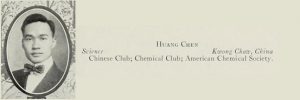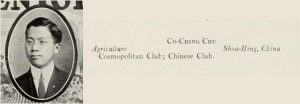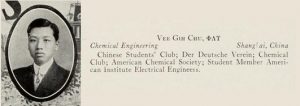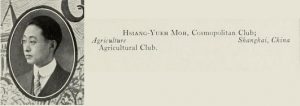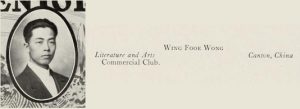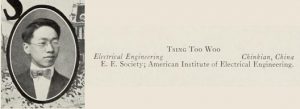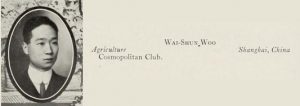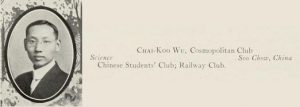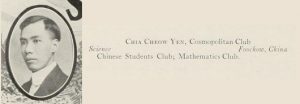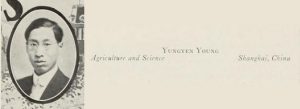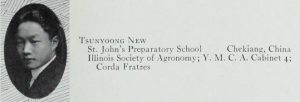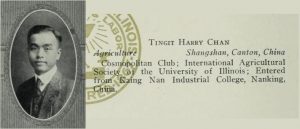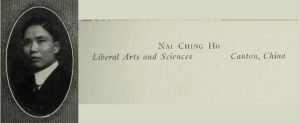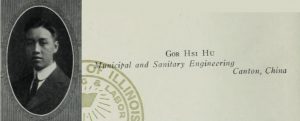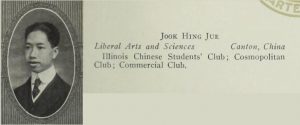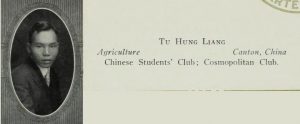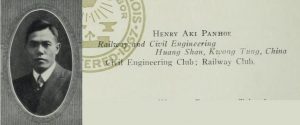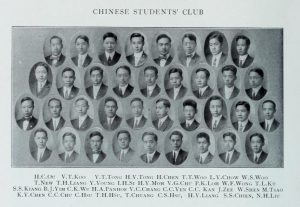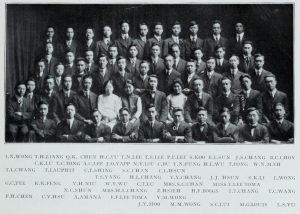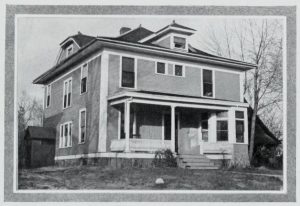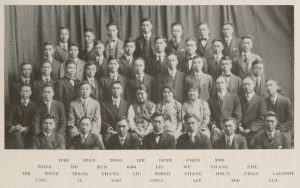Since at least 1906, Chinese students have been attending the University of Illinois. Early Chinese Illini have included accountants, agriculturalists, architects, architectural engineers, business administrators, chemical engineers, chemists, civil engineers, economists, educators, electrical engineers, English majors, entomologists, historians, home economists, lawyers, mathematicians, metallurgical engineers, municipal and sanitary engineers, physicists, political scientists, railway administrators, railway engineers, student leaders, and translators too.
Read on to learn more about early Chinese Illini!
Early Alumni in China
Before the first Chinese students came to the University of Illinois, a few Illini went to China first. In fact, it may be that many early Illini took missionary jobs in China and some worked in hospitals too. Among the first of the Illini in China was Mr. Charles W. Young, (B.S. Science, 1897), of Chicago, who worked briefly as a principal at a high school in Sullivan, Illinois, before attending medical school at Johns Hopkins University, and before becoming a missionary and teacher at the Union Medical College in Peking in 1904. [1] At the same, there was also a Mr. Raymond Craver Ricker, (B.S. Architectural Engineering, 1900), of Grinnell, Iowa, worked as an architect in Moline and Rock Island, before entering missionary work in China. In 1904, Mr. Ricker joined a mission in Tzechow, with a high school teaching appointment in Chengtu (now Chengdu) in 1907, before becoming a district superintendent in 1908 and later becoming a superintendent of construction at the University of Chengtu (now West China Union University). [2] The following year, it was Ms. Ruth Bennett, (A.B. 1899; A.M. Mathematics, 1908; PhD Mathematics, 1910), of Morton, Illinois, who continued her studies in medicine at Johns Hopkins University, before joining the medical mission in Tsing Kiang, (1905-1910) and Haichow (now Lianyungang) in 1910. [3]
Every year, for the next few years, more alumni would join missions in China. There was Mr. Elrick Williams, (A.B. Chemistry, 1902; A.M. Chemistry, 1903), of Illiopolis, Illinois, who worked briefly as a chemistry instructor at Illinois, before joining an educational mission in Chengdu from 1906 until 1912, where he would work as a principal of the Boy’s Day and Boarding School and later in the Chemistry Department of the West China Union University. [4] Later, Ms. Ethel I. Dobbins, (A.B. 1902), of Ipava, Illinois, pursued a career in religious education after graduation, including studying at the Bible Teachers’ Teaching School in New York (later Biblical Seminary of New York), before becoming a student secretary at a mission in Foochow (now Fuzhou) from 1908 until 1909. [5] Next was Ms. Alice Emily Maddock, (A.B. Science, 1907), of Guelph, Ontario, Canada, who worked briefly as a band teacher in Batavia, Illinois, before taking a similar position in Wuhu from 1908 until 1911. [6]
At least one Illini couple married in China. A Ms. Florence Somers, (A.B. 1907), of Panola, Illinois, married Mr. Elrick Williams (see above) in Chungking (now Chongqing) before working as a missionary in Chengdu from 1909 until 1912. [7] Just one year later, it was Ms. Lucinda P. Boggs, (A.B. 1894), of Hayes, Illinois, studied in Europe and at Cornell, after graduation, before teaching at Rice, Washington State Normal School, and Western College for Women in Oxford Ohio, and before joining an educational mission in China from 1910-1912. Later, Dr. Boggs wrote a book about womanhood in China. [8] There was also a Mr. Albert Menzo Dunlap, (B.S. Science, 1906), of Savoy, Illinois, completed medical degree at Howard University, before working at a medical school in Shanghai. Mr. Dunlap later wrote a memoir of his experiences as a medical doctor in China. [9]
Some Illini women took positions as educators in China. There was a Ms. Thirza M. Pierce, (A.B. 1911; A.M. 1917), of Hanover, Illinois, who took a position as a teacher at the University of Nanking, after graduation. [10] Also, there was a Ms. Minnie Vautrin, (A.B. Science, 1912), of Secor, Illinois, who took a position as a missionary teacher at a girl’s school in Lu Chow Fu (now Hefei). Ms. Vautrin remained in China for twenty-eight years, she eventually became a Dean of Gingling College, and she was a witness to the Nanking Massacre too. Ms. Vautrin’s correspondence and diaries were published in 2008 by the University of Illinois Press. [11] And there was a Ms. Mae Chapin, (A.B. 1908), of Tolono, Illinois, who was an English and history teacher in Williamsport, Indiana, and in Chicago too, before becoming a missionary and superintendent of a girl’s school in Kiung Chow in 1913. [12]
The instructors kept coming. There was a Ms. Emma Lodema Ehly, (A.B. 1907), of Ottawa, Illinois, who joined a mission as a teacher in “Yemping” in 1915 and in a girl’s school in “Haijawg” too. [13] Later came an older alumni, a Mr. Charles W. Woodworth, (B.S. Natural History, 1886; M.S. Natural History, 1886), of Champaign, who worked at an Agricultural Experiment Station in Arkansas, as well as teaching in California, before assisting in the planning of entomological work at the University of Nanking from 1917 until 1918. [14] Architects came too. It was a Mr. Charles A. Gunn, (B.S. Architecture, 1892), of Chicago, who worked in architecture in New York and Pittsburgh for years, until becoming a Missionary Architect in the Philippines, Southern China, and Hawaii in 1916. [15]
And more instructors came. A Ms. Lois M. Miles, (A.B. Latin, 1909; A.M. Classics, 1914), of San Luis Valley, Colorado, worked briefly for the University of Illinois until taking a teaching position at Tsing Hua College (now Tsinghua University) in 1916. [16] And Ms. Miles’ spouse, Mr. Adolf E. Zucker, (A.B. German, 1912; A.M. German, 1913), of Fort Wayne, Indiana, took an instruction position at Tsing Hua too.
Mr. Edward L. Hall, (A.B. 1908), of Danville, Illinois, later attended the University of New York, after graduation, before becoming secretary of the international committee of the Y.M.C.A. from 1915 through 1917, until becoming Education Secretary of the Y.M.C.A. in Hankow (now Hankou) in 1917. [17] And Mr. Ralph G. Mills, (A.B. Science, 1903), of Lincoln, Illinois, completed a medical degree at Northwestern University Medical School, before working at Severance Medical College of Korea and later at Peking Union Medical College in 1918. [18]
Students
The earliest Chinese Illini may have arrived on campus as early as 1906 (and readers interested in even more information should be sure to read Dr. Carol Huang’s (PhD Education, 2001) dissertation, and Broadcast Journalism alumni Mr. Xing Zhuo’s 2014 documentary “From China to Urbana-Champaign“, as well as this 2016 student-produced video too). In fact, a quick review of the Illini Directories (Record Series 26/4/801) reveals the names of many early Chinese students including some who left before graduation. Early Chinese Illini faced not only the challenges of studying abroad on another continent; but, they were also studying during the end of the last imperial dynasty of China and some later students’ educations were interrupted by events surrounding the Chinese Revolution of 1911.
Some of the earliest Daily Illini articles including Chinese Illini experiences featured students like Mr. Ching-Chun Wang, (M.A. Economics, 1909, PhD Economics, 1911) who was a graduate student who came to Illinois after completing a bachelors degree at Yale University. While he was a student, Mr. Wang was active in student life, including giving a Cosmopolitan Club talk “The Confucian Idea of a Student”, serving as the 1909 Club president too, giving the opening speech for the 1909 Chinese New Year social party, giving a talk about Beijing for the 1909 Chinese Night program (it was well-received in the DI), lecturing on the Chinese history and culture for an off-campus educational program, serving as the Club treasurer during a Red Cross fundraiser, speaking on East Asian politics for the Political Science Club, serving as the national Cosmo Club president in 1910, and being the first Chinese student to receive a PhD from the University of Illinois. But, amid all of his work, Mr. Wang had setbacks too. For example, in the March 1910 Cosmopolitan Club House fire, Mr. Wang lost a manuscript which he had been writing for two years.
In 1908, a degree of Doctor of Laws was conferred to Imperial Chinese Envoy Extraordinary and Minister Plenipotentiary to the United States of American Wu Tingfang, and he gave the 1908 commencement address “Why China and America Should Be Friends” too. Photographs and other documentation of his visit can be viewed at the University Archives.
Class of 1909
Mr. Wenfu Y. Hu, (sometimes listed as “Hu I-ku“) (LL.B., 1909), of Ningpo (now Ningbo), prepared at St. John’s University of Shanghai and the University of Chicago, before coming to Illinois. [19] While he was a student, Mr. Hu was a contributor to the Class of 1909 Memorial Fund. After graduation, Mr. Hu was a Law Professor at Imperial University (1909-1912) and a legal advisor of the Board of Communications in Beijing. Not long after, Mr. Hu served a distinguished career in Chinese law, including an appointment as a justice of the second branch of the Kiangsu (now Jiangsu) High Court, The Daily Illini reported. In 1931, he presided over a Chinese alumni dinner which hosted Former University President Dr. David Kinley during a China trip too.
Mr. Tinph W. Tu, (B.S. Railway Engineering, 1909), of Soochow (now Suzhou), prepared at Nanyang College and the University of California, before coming to Illinois. [20] While he was a student, Mr. Tu gave a talk on the differences between Gregorian and Chinese calendars at an early Chinese New Year social event in 1909, he performed a musical composition “The Golden Lily” with two other students for a Cosmopolitan Club program, and he was a Club treasurer in 1909 too. After graduation, Mr. Tu worked as a transitman in Chicago, then an Assistant transitman in Kansas City, Missouri, before becoming an Assistant engineer in Shanghai. By 1921, Mr. Tu had become an assistant chief of the maintenance of way department of the Chinese Eastern Railroad, and he served as the technical secretary for the Chinese representative at a Washington meeting (Conference on the Limitation of Armament) too, The Daily Illini reported.
Class of 1910
Mr. Khoo-Din S. Tsiang, (A.B. 1910; B.S. 1911), of Shanghai, prepared at St. John’s University of Shanghai, before coming to Illinois. [21] Mr. Tsiang was reportedly a great storyteller at the 1909 Chinese New Year campus social, a performer at the 1909 Cosmo Club Chinese Cultural night, (the event was a great success, as The Daily Illini reported), and in 1909 he was the Illini chapter secretary for the national publication Chinese Students’ Monthly.
The following year when the 1911 Chinese Revolution had begun and while some students remained, some students returned to China. In fact, some students returned to join the revolution. Some students kept correspondence with friends at Illinois, like C. Y. Teng who decided to complete his chemical engineering studies in China to watch-over his family and friends in China. In 1912, after the fighting had ended, the Choral Society organized a fundraiser for famine victims, performing “The Swan and the Skylark” as a benefit concert in April.
Class of 1911
Mr. Juedan T. Zhen, (A.B. Railway Administration, 1909; A.M. Railway Administration, 1911), of Suzhou, prepared at Nanyang College, the University of California, and the University of Wisconsin, before coming to Illinois. [22] While he was a student, we know that Mr. Zhen was the chairman of the 1909 Cosmopolitan Club Chinese cultural program. After graduation, Mr. Zhen took a position as an accountant in the Division of Railway Accounts and Statistics of the Ministry of Communications.
Mr. Hua C. Ou, (B.S. Agriculture, 1911; A.B. Science, 1911; M.S. Agronomy, 1912), of Weichow, prepared at Nanyang Academy, before coming to Illinois. [23] While he was a student, Mr. Ou wrote at least one editorial for the Daily Illini, where he argued that the University was in need of a student honor policy–and he utilized multiple Chinese adages and proverbs too. After graduation, Mr. Ou took a position as Chief of the Bureau of Industry on Hainan Island, in 1914. Later, he was general manager of the Kwongmee Agricultural College. By 1915, he was Director of Studies at First Agriculture College. Not long after, he was Director of the Provincial Experiment Station in Anhui in 1916. By 1917, Mr. Ou was a candidate member of the Chinese National Congress and an advisor to President Lai.
Mr. Chuan P. Yin, (A.B. Business Administration, 1911), of Suzhou, prepared at the University of California, before coming to Illinois. [24] After graduation, Mr. Yin later became Manager and Director of the Shanghai-Nanking Railway.
Class of 1912
Mr. Vun-Din C. Chang, (B.S. Agriculture, 1912; M.S. Agronomy, 1913), of Shanghai, prepared at St. John’s University, before coming to Illinois. [25] While he was a student, Mr. Chang was elected Cosmopolitan Club recording secretary for 1910, spoke at a 1913 Chinese student program which explained the 1911 Chinese Revolution (also known as the “Xinhai Revolution“) to fellow students, he published an article in the student publication Illinois Magazine (Record Series 15/7/810) titled “What the University of Illinois Means to the Students from China” just one month after giving a similar campus talk, After graduation, in 1914, Mr. Chang would become Assistant Field Director of the Chinese National Oil Administration.
Mr. Chi Hsu, (B.S. Civil Engineering, 1912), of Kwongtung (now Guangdong), prepared at Tong Shan Engineering and Mining College, before coming to Illinois. [26]
Class of 1913
Mr. Huang Chen, (B.S. Chemical Engineering, 1913), of Canton, prepared at the Engineering and Mining College of China, before coming to Illinois. [27] After graduation, Mr. Chen continued his graduate students at the Massachusetts Institute of Technology.
Mr. King Yaou Chen, (B.S. Chemical Engineering, 1913), of Shanghai, prepared at the Imperial Polytechnic Institute, before coming to Illinois. [28] After graduation, he too continued his graduate students at the Massachusetts Institute of Technology.
Mr. Co Ching Chu, (B.S. Agriculture, 1913), of Shoa Hing, Chi-Kiang, prepared at Tong-shan Engineering College, before coming to Illinois. [29] While he was a student, Mr. Chu was the English secretary of Chinese Students Club in 1912.
Mr. Vee Gih Chu, (B.S. Chemical Engineering, 1913), of Nanhui, prepared at Lawrence Academy of Groton, Massachusetts, before coming to Illinois. [30] While he was a student, Mr. Chu read at least one paper for the campus-based Chemical Journal meetings, in 1912, and he participated in at least one campus trip to inspect chemical laboratories in Chicago in 1912 too.
Mr. Pao Kan Loh, (B.S. Agriculture, 1913), of Changshu, also prepared at Lawrence Academy, before coming to Illinois. [31]
Mr. Hsiang Yueh Moh, (B.S. Agriculture, 1913), of Shanghai, prepared under a private tutor, at the University of Wisconsin, St. Xavier’s School, and the Agricultural and Mechanical College of Texas, before coming to Illinois. [32] While he was a student, Mr. Moh was a Chinese Students’ Club president, in 1912, he translated a romantic drama titled “Siksiang, or the Chinese Romeo and Juliet” into English for the Illinois Magazine, even the Daily Illini previewed the publication, he spoke on Confucian classic texts for the off-campus Unitarian Church in September, he spoke on Chinese Agriculture for the Agriculture Club in October, and by February 1918, Mr. Moh was a manager for a spinning factory in Shanghai, the DI reported.
Mr. Wen Yii Shen, (B.S. Agriculture, 1913), of Shantung Province (now Shandong Province), prepared at the Shantung Provincial High School, before coming to Illinois. [33] It is possible that Mr. Shen intended to continue his graduate studies in the U.S. ; however, by January 1914, he had returned to China “because of ill health”, the DI reported.
Mr. Wing Fooe Wong, (A.B. Business, Literature, and Arts, 1913), of Canton (now Guangzhou), prepared at the Cascadilla School of Ithaca, New York, before coming to Illinois. [34]
Mr. Tsing Too Woo, (B.S. Electrical Engineering, 1913), of Tachow, prepared at the Lawrence Academy of Ithaca, New York, before coming to Illinois. [35] While he was a student, Mr. Woo attended at least one student trip to visit the Keokuk Dam and plants in Chicago, and he was also elected to the honorary scientific fraternity Sigma Xi in 1913.
Mr. Wai Shun Woo, (B.S. Agriculture, 1913), of Canton (now Guangzhou), prepared at a high school in Madison, Wisconsin, before coming to Illinois. [36]
Mr. Chai Koo Wu, (A.B. Science, 1913), of Soochow (now Suzhou), prepared at Nanyang High School in Shanghai, before coming to Illinois. [37] While he was a student, Mr. Wu was chairman of the Chinese Students Club in 1912 and he was toastmaster for a dinner honoring a campus visit by Dr. C. C. Wang in October of that year. In November, with L. T. Zee and Japanese Illini Genjior Jiuguji, the three Cosmopolitan Club members organized a musical program. In December, Mr. Wu performed a dance at the annual Junior “smoker” social night too.
Mr. Chia Cheow Yen, (A.B. Science, 1913), of Foochow (now Fuzhou), prepared at a Wesleyan Academy, before coming to Illinois. [38] While he was a student, Mr. Yen gave a Mathematics Club talk about mathematical education theory, in 1913, and he was chairman for the Fourth Annual Chinese Students’ Alliance Mid-West Section conference in August 1913 too. After graduation, by 1923, Mr. Yen had become a leading figure in the cotton industry of China, the DI reported. In 1925, Mr. Yen had become president of the Nanking-Shanghai railroad, the DI reported.
Mr. Yungyen Young, (A.B. Science, 1913; M.S. 1914), of Nanziang, also prepared at Lawrence Academy of Groton, Massachusetts, before coming to Illinois. [39] While he was a student, Mr. Young wrote at least one editorial for the Daily Illini, in which he responded to a recent campus talk about the history of Chinese civilization by politely correcting errors and by providing additional information for interested readers too.
Class of 1914
Mr. Sung Shu Chien, (A.B. Sciences, 1914), of Shanghai, prepared at the local Nan Yang High School, before coming to Illinois. [40] While he was a student, Mr. Chien was the Chinese secretary for the Chinese Students’ Club, in 1912.
Mr. Trin Chuang, (B.S. Architectural Engineering, 1914) of Shanghai, prepared at the Tong Shan Engineering College, before coming to Illinois. [41] While he was a student, Mr. Chuang joined an early Illinois study abroad program which featured tours of England, France, and Italy, led by Architecture Professor N. A. Wells.
Mr. Tsuny Han Hsu, (A.B. Science, 1914), of Shantung, prepared at the Shantung Provincial High School, before coming to Illinois. [42] In 1911, the Daily Illini interviewed Mr. Hsu and other Chinese Illini for their perspectives on the Chinese Revolution.
Mr. Chen Chi Kan, (B.S. Literature, Arts, and Science, 1914), of Shanghai, prepared at the Nan Yang Academy, before coming to Illinois. [43] In 1913, Mr. Kan and other international Illini were invited to give talks about commerce and society abroad, for the Champaign Chamber of Commerce. After graduation, Mr. Kan went to Pennsylvania to continue his studies.
Mr. Vi Tsing Koo, (B.S. Electrical Engineering, 1914), of Kiangsu Province (now Jiangsu Province), prepared at the Imperial Polytechnical College, before coming to Illinois. [44] In 1912, Mr. Koo was the Chinese Students’ Club treasurer, and during the Spring 1913 term, he joined the Cosmopolitan Club too.
Mr. Tsong Lin Ku, (A.B. Literature, Art, and Science, 1914), of Shac-Shing, prepared at the Ching Hua College, before coming to Illinois. [45]
Mr. Ying Nan Lee, (A.B. Sciences, 1914), of Canton, prepared at the Queen’s College in Hong Kong, before coming to Illinois. [46]
Mr. Tsunyoong New, (B.S. Agriculture, 1914), of Ningpo (now Ningbo), prepared at St. John’s Preparatory School, before coming to Illinois. [47]
Mr. William Sing-Chong Pung, (B.S. Railway Engineering, 1914; M.S. Railway Engineering, 1915), was the son of Chinese immigrants to Honolulu Hawaii, where he prepared at the Oahu College, before coming to Illinois. [48] Mr. Pung was active in multiple student organizations, like Civil Engineering Club, Railway Club, as well as both Cosmopolitan Club and Chinese Students’ Club too. After graduation, Mr. Pung took a position as a resident engineer for the Santa Fe Railroad at Cushing, Oklahoma, the DI reported.
Mr. Nim Chi Shum, (B.S. Science, 1914; M.S., 1915), of Canton, prepared at the Cook Academy High School of Montour Falls, New York, before coming to Illinois. [49]
Mr. Kwang Tang Teng, (A.B. Literature, Art, and Science, 1914), of Canton, prepared at Peiyang University (now Tianjin University), before coming to Illinois. [50]
Mr. Jeshine Zohn Zee, (B.S. Electrical Engineering, 1914), of Shanghai, prepared at St. John’s University of Shanghai, before coming to Illinois. [51]
Class of 1915
Mr. Yun Tin Cheng, (A.B. Literature, Art, and Science), of Kwong Tung, prepared at St. Stephens College, before coming to Illinois. [52]
Mr. Kaimin Kay Feng, (B.S. Civil Engineering, 1915; M.S. Civil Engineering, 1916), of Kwangsi Province (now Guangxi Province), prepared at the Nanyang College of Shanghai, before coming to Illinois. [53]
Mr. Gooey Yen Fong, (B.S. Electrical Engineering), of Canton, prepared at the Kwang-Tung Province High School, before coming to Illinois. [54]
Mr. Nai Ching Ho, (A.B. Literature, Art, and Science), of Canton, prepared at Queen’s College, before coming to Illinois. [55]
Mr. Jook Hing Jue, (A.B. Literature, Art, and Science), of Canton, prepared at a high school in Berkeley, California, before coming to Illinois. [56]
Mr. Tu Hung Liang, (B.S. Agriculture), of Canton, prepared at the Tientsin Agriculture College, before coming to Illinois. [57]
Mr. Henry Aki Panhoe, (B.S. Civil Engineering), of Huang Shan, prepared at the Pomona College Preparatory High School, before coming to Illinois. [58] While he was a student, Mr. Panhoe was part of the 1913 Senior Stag, an invited speaker (on Hawaii) for the Champaign Chamber of Commerce, and he designed a window display on China and Hawaii for Lloyde’s University Supply Store in 1914. In 1913, Mr. Panhoe and other Chinese Illini arranged to have the traveling Chinese Baseball team of Hawaii to visit the campus.
Class of 1916
Mr. Hsi Fan Boggs, (A.B. Commerce), of Chikiang, prepared at the Nanyang High School, before coming to Illinois. [59]
Mr. Tien Tsai Chang, (B.S. Agriculture), of Canton, prepared at a preparatory school of Peking University (now Beijing University), before coming to Illinois. [60]
Mr. Lan-Sung Chen, (A.B. Commerce, 1916; A.M. Commerce, 1917), of Tientsin, prepared at a school in Tientsin, before coming to Illinois. [61]
Mr. Tso Chang Hao, (A.B. Commerce, 1916; A.M. Commerce, 1917), of Tientsin, also prepared at local school, before coming to Illinois. [62]
Mr. Chi Tsing Lu, (B.S. Mining Engineering), of Kiangsi, prepared at Kiangsi College and the University of Pittsburgh, before coming to Illinois. [63]
Mr. Yin Hsiang Niu, (B.S. Railway Engineering), of Huchow, Chekiang, prepared at the Drexel Institute of Philadelphia, before coming to Illinois. [64]
Mr. Te Chang Wang, (B.S. Agriculture, 1916; M.S. Agriculture, 1917), of Soochow, prepared at the College of Languages in Pekin, before coming to Illinois. [65]
Of course there were graduate students too. Among the earliest Chinese Illini graduates included: Luan Chang, (M.S. Civil Engineering, 1913); Pau Sien Chung, (M.S. Animal Husbandry, 1918); Chuan-Ying Hsu, (A.M. Railway Administration, 1915, PhD 1917); Tsung Han Hsu, (A.M. 1915); Ching Lee Hsun, (A.M. Physics, 1918); Jin Jee Hsun, (M.S. Chemistry, 1918); Ma-Li Liang Tze Lee, (A.M. Education, 1915); Yi Liu, (M.S. 1918); Peter Soo-Hoo, (M.S. Civil Engineering, 1911); Wen Tsing Tao, (A.M. Political Science, 1915); Yang Feng Tseng, (M.S. Civil Engineering, 1918); Ying-Hsuan Hsuwen Tsou, (M.S. Entomology, 1913); Tseh Ling Tsu, (A.M. History, 1918); Chi Nyok Wang, (A.M. Botany, 1917); Ching-Chun Wang, (M.A. Economics, 1909, PhD Economics, 1911); and Te Chang Wang, (M.S. Agriculture, 1917), to name a few.
Organizations and Special Events
Chinese Students’ Club
One of the first Chinese student organizations was the Chinese Students’ Club. As early as 1910, Chinese Illini began to meet regularly as group. The content of the meetings varied. At a February 1912 meeting, the club discussed the future of Chinese student education opportunities in the United States. When Chinese Illini alumni Dr. C. C. Wang visited campus in October 1912, the Club co-hosted a luncheon at the Cosmopolitan Club house and they independently organized a banquet at the local Beardsley Hotel. Their early events may have been quiet popular across campus, as evidenced in a January 1913 social event which exceeded their reserved space in Morrow Hall.
The CSC was active on campus. At least as early as 1916, they joined other students in the annual campus circus program. In July 1916, the CSC organized and performed the play “The Life of Shao” which was performed in Chinese; but, they included a synopsis in English before the show too. On October 10 1916, in enthusiastic observance of the independence day holiday, some students cut classes and a large party was hosted in the club house, featuring informal talks in English and Chinese. The 1917 independence day party included a magic performance and musical program performed by club members. By 1918, the CSC was organizing as many as six events per year, including hosting their colleagues in the Cosmopolitan Club on one occasion and University faculty on another occasion, in addition to hosting the 1918 annual meeting of Midwest Chinese Students’ Alliance too. The 1919 independence party included talks and games. And in 1920, they organized a performance of a play titled “Rainbow” which was a play written by a Chinese student studying in the U.S., the DI reported. Proceeds from this play were donated to the American Red Cross too.
In 1911, the Chinese Students’ Agricultural Club was formed and it might have been the second Chinese student organization on campus. According to DI reporting, the CSAC formed to present agricultural papers and to translate the research into Chinese for the benefit of Chinese researchers in China. At least one other public event was hosted in February 1911. More reports of the Agricultural Club have not been identified yet. However, while two organizations had formed during the first decade of Chinese Illini enrollment, a greater variety of cultural exchange programs would be organized by Chinese students during the coming years, as the Chinese Illini story had only just begun.
Are you a Chinese Illini? Do you know someone who is? We’d like to hear from you! Please send us a message or leave a comment below. We want to include you and your story, as we celebrate the first 150 years of the University of Illinois.
Happy First 150 everyone!
References
[] As always, a special thank you to all students and staff whose tireless work for student life and publications (many of which are available at the University Archives) help preserve the memories of Illini everywhere.
[1] “Charles Whittier Young”, The Semi-Centennial Alumni Record of the University of Illinois, Edited by Franklin W. Scott, page 107.
[2] “Ruth Bennett (Morgan)”, page 117.
[3] “Elrick Williams”, page 173.
[4] “Ethel Irene Dobbins (Sampson), page 160.
[5] “Raymond Craver Ricker”, page 135.
[6] “Alice Emily Maddock”, pager 286.
[7] “Florence Somers (Williams)”, pager 294.
[8] “Lucinda Pearl Boggs”, page 76.
[9] “Albert Menzo Dunlap”, page 248.
[10] “Thirza May Pierce”, page 433.
[11] “Minnie Vautrin”, page 478.
[12] “Mae Chapin”, page 305.
[13] “Emma Lodeam Ehly”, page 275.
[14] “Charles William Woodworth”, page 43.
[15] “Charles Alexander Gunn”, page 66.
[16] “Lois Maia Miles (Zucker)”, page 389; “Adolf Edward Zucker”, page 480.
[17] “Edward Leverich Hall”, page 312.
[18] “Ralph Garfield Mills”, page 185.
[19] “Wenfu Yiko Hu”, page 344.
[20] “Tinph Weitsen Tu”, page 364.
[21] “Khoo-Din Su-Peh Tsiang”, page 401.
[22] “Juedan Tun-Shon Zhen”, page 405.
[23] “Hua Ching Ou”, page 432.
[24] “Chuan Pong Yin”, page 443.
[25] “Vun-Din Chinzun Chang”, page 450.
[26] “Chih Hsu”, page 460.
[27] “Huang Chen”, page 486.
[28] “King Yaou Chen”, page 486.
[29] “Co Ching Chu”, page 486.
[30] “Vee Gih Chu”, page 486.
[31] “Pao Kan Loh”, page 500
[32] “Hsiang Yueh Moh”, page 503.
[33] “Wen Yii Shen”, page 511.
[34] “Wing Fooe Wong”, page 517.
[35] “Tsing Too Woo”, page 517.
[36] “Wai Shun Woo”, page 517.
[37] “Chai Koo Wu”, page 518.
[38] “Chia Cheow Yen”, page 518.
[39] “Yungyen Young”, page 518.
[40] “Sung Shu Chien”, page 526.
[41] “Tsin Chuang”, page 526.
[42] “Tsuny Han Hsu”, page 538.
[43] “Chen Chi Kan”, page 539.
[44] “Vi Tsing Koo”, page 541.
[45] “Tsong Lin Ku”, page 541.
[46] “Ying Nan Lee”, page 541.
[47] “Tsunyoong New”, page 546.
[48] “William Sing-Chong Pung”, page 549.
[49] “Nim Chi Shum”, page 554.
[50] “Kwang Tang Teng”, page 557.
[51] “Jeshine Zohn Zee”, page 562.
[52] “Yun Tin Cheng”, page 569.
[53] “Kaimin Kay Feng”, page 574.
[54] “Gooey Yen Fong”, page 575.
[55] “Nai Ching Ho”, page 580.
[56] “Jook Hing Jue”, page 582..
[57] “Tu Hung Liang”, page 585.
[58] “Henry Aki Panhoe”, page 591.
[59] “Hsi Fan Boggs”, page 610.
[60] “Tien Tsai Chang”, page 613.
[61] “Lan-Sung Chen”, page 613.
[62] “Tso Chang Hao”, page 622.
[63] “Chi Tsing Lu”, page 633.
[64] “Yin Hsiang Niu”, page 639.
[65] “Te Chang Wang”, page 652.



